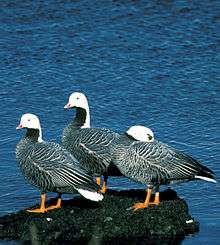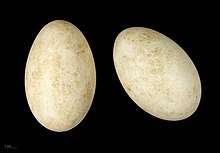Emperor goose
| Emperor goose | |
|---|---|
 | |
| Scientific classification | |
| Kingdom: | Animalia |
| Phylum: | Chordata |
| Class: | Aves |
| Order: | Anseriformes |
| Family: | Anatidae |
| Genus: | Anser |
| Species: | A. canagicus |
| Binomial name | |
| Anser canagicus (Sevastianov, 1802) | |
| Synonyms[2] | |

The emperor goose (Anser canagicus) is a species of goose. It breeds around the Bering Sea, mostly in Alaska, United States, but also in Kamchatka, Russia. It is migratory, wintering mainly in the Aleutian Islands. The species is listed as Near Threatened by the IUCN.
.jpg)

This goose has a stout gray body, subtly barred with fine barring, and a white head and hindneck, often stained orange from iron-rich waters. Unlike the blue-morph snow goose, the white does not extend onto the front of the neck. The sexes are similar, but immatures have the head the same color as the body.
This species is much less gregarious than most geese, usually occurring in family groups. It breeds on coastal tundra, laying 3–7 eggs in a ground nest.
Breeding birds molt near the breeding colonies, but non-breeders move to St. Lawrence Island to molt prior to the main migration to the rocky coastlines of the wintering grounds.
The food of this goose is typically composed of shoreline grasses and other coastal plants.
References
- ↑ BirdLife International (2012). "Anser canagicus". IUCN Red List of Threatened Species. Version 2013.2. International Union for Conservation of Nature. Retrieved 26 November 2013.
- ↑ Rockwell, Robert F.; Petersen, Margaret R.; Schmutz, Joel A. (1996). "Appendix A. Scientific nomenclature used for emperor geese". The Emperor Goose: An Annotated Bibliography. Biological Papers of the University of Alaska. 25. Fairbanks: Institute of Arctic Biology. p. 80. hdl:11122/1501. ISSN 0568-8604.
- ↑ Sewastianoff, [A. F.] (1802). "Description d'une nouvelle espèce de canard et d'une varieté de l'huitrier, qui se trouvent dans le cabinet d'histoire naturelle de l'Académie impériale des sciences". Nova Acta Academiae Scientiarum Imperialis Petropolitanae. 13: 346–351.
- ↑ Bannister, B. H. (1870). "A Sketch of the Classification of the American Anserinæ". Proceedings of the Academy of Natural Sciences of Philadelphia. 22 (3): 131. JSTOR 4624119.
| Wikimedia Commons has media related to Emperor Goose. |
- National Audubon Society and American Bird Conservancy (2007), 2007 WatchList. Retrieved on 21 February 2008. Database entry with information on life history and population trends.
External links
- Emperor Goose videos, pictures, and sounds from the Internet Bird Collection
